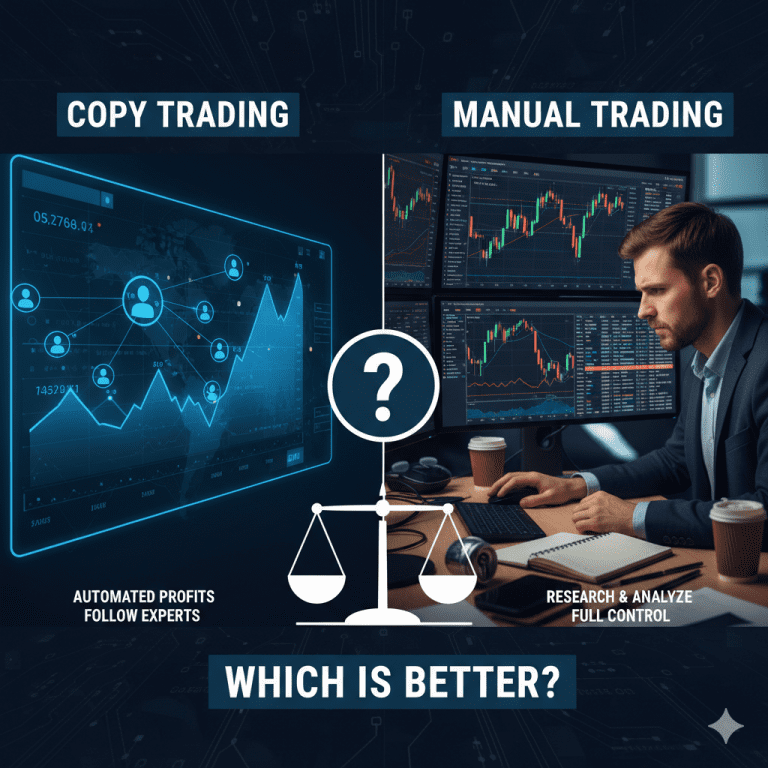Introduction to Trading Methods
In the financial markets, trading strategies have evolved significantly with technology. Today, traders can choose between manual trading, where they make their own decisions, and copy trading, which allows them to mirror the trades of experienced investors automatically. Understanding the differences, advantages, and disadvantages of each approach is critical for anyone seeking to maximize returns while managing risk effectively.
Trading decisions directly impact profitability, risk exposure, and learning opportunities. This guide provides a comprehensive comparison of copy trading and manual trading, helping you make an informed choice suited to your trading style, experience, and financial goals.
What is Manual Trading?
Manual trading, also known as discretionary trading, is the traditional approach where the trader analyzes markets, executes trades, and manages positions personally. This method requires a solid understanding of market dynamics, technical analysis, and risk management strategies.
Key Features of Manual Trading
Manual trading gives full control over decisions. Traders select which assets to trade, when to enter and exit positions, and how much capital to allocate. It allows flexibility in strategies, including day trading, swing trading, scalping, or long-term investing. Each trade provides hands-on learning and an opportunity to refine analytical skills.
Example of Manual Trading
Imagine you are trading forex. You analyze currency pairs, consider economic indicators, and detect patterns using technical tools like candlestick charts and moving averages. Based on your research, you decide to buy EUR/USD at 1.1050, set a stop-loss at 1.1000, and a take-profit at 1.1200.
Advantages of Manual Trading
Manual trading offers complete control over trading decisions. It allows the potential for higher profits for skilled traders. Strategies can be customized to personal preferences. Each trade provides direct learning experience.
Disadvantages of Manual Trading
Manual trading is time-consuming because it requires constant market monitoring. It demands extensive knowledge and experience. Emotional bias can affect decision-making. High stress is common during volatile market conditions.
What is Copy Trading?
Copy trading allows traders, especially beginners, to automatically replicate the trades of experienced traders. This method is popular on platforms like eToro, ZuluTrade, and Covesting.
Key Features of Copy Trading
Copy trading provides automation. Once a trader is chosen to follow, trades are mirrored in your account. It is accessible to beginners without advanced market knowledge. Many platforms provide metrics on traders’ past performance, risk levels, and trading style.
Example of Copy Trading
Suppose you select a professional trader who specializes in cryptocurrency trading. They place a trade to buy Bitcoin at 50,000 USD. Your account automatically copies this trade proportionally based on the amount you allocated. If Bitcoin rises to 55,000 USD, you profit without needing to analyze the market personally.
Advantages of Copy Trading
Copy trading is easy for beginners. It saves time because trades are automated. You can diversify risk by following multiple traders. Copy trading also allows learning from successful traders’ strategies.
Disadvantages of Copy Trading
Copy trading offers less control over individual trades. It depends on another trader’s skill and judgment. There is potential for over-reliance on past performance. Fees or commissions may reduce net profits.
Comparing Copy Trading and Manual Trading
Understanding the differences between these two approaches helps you choose the method aligned with your goals, risk tolerance, and availability.
Manual trading gives full control and hands-on learning, but it requires time, knowledge, and emotional discipline. Copy trading is automated and accessible, but relies on the performance of others and provides less control. Manual trading can offer higher profits for skilled traders, while copy trading allows beginners to participate with lower effort.
Risk Considerations
Both manual and copy trading involve financial risk. Market volatility affects both methods and can lead to sudden price fluctuations. Emotional trading can influence manual traders. Copy trading relies on the skill and honesty of the trader being followed. Over-diversification in copy trading can reduce returns, while over-trading in manual trading can increase costs.
Choosing the Right Approach for You
Selecting between manual and copy trading depends on experience, time availability, financial goals, and risk tolerance.
Experience Level: Beginners may benefit from copy trading to learn while reducing risk. Experienced traders may prefer manual trading for strategic control and potentially higher profits.
Time Availability: Manual trading requires constant monitoring and analysis. Copy trading is suitable for those who cannot dedicate extensive time to markets.
Financial Goals: Manual trading allows customization of risk and investment size. Copy trading offers steady exposure and diversification without deep market involvement.
Risk Tolerance: High-risk takers may prefer manual trading to exploit opportunities. Risk-averse traders may choose copy trading for a more controlled approach.
Combining Both Strategies
Some traders adopt a hybrid approach. They use manual trading for high-conviction trades and copy trading for diversification and learning. This allows capital allocation according to confidence levels and risk appetite, combining the benefits of control and automation.
Tips for Successful Trading
Research and due diligence are critical. Analyze the markets or evaluate the performance of traders you intend to copy. Use risk management tools like stop-losses and limit orders, and allocate capital wisely. Continuously learn about market trends, economic indicators, and trading strategies. Diversify by not putting all funds in one asset or following only one trader. Regularly review performance and adjust your strategy accordingly.
Conclusion
There is no single answer to whether copy trading or manual trading is better. Each method has advantages and challenges. Manual trading offers full control, hands-on learning, and potential for higher profits but requires skill, time, and emotional discipline. Copy trading provides accessibility, automation, and learning opportunities, particularly for beginners or busy investors, but relies on the performance of others and reduces control.
The best choice depends on trading experience, time availability, financial goals, and risk tolerance. Many traders find a hybrid approach combining both methods to be the most effective way to benefit from automation while maintaining strategic control.






















